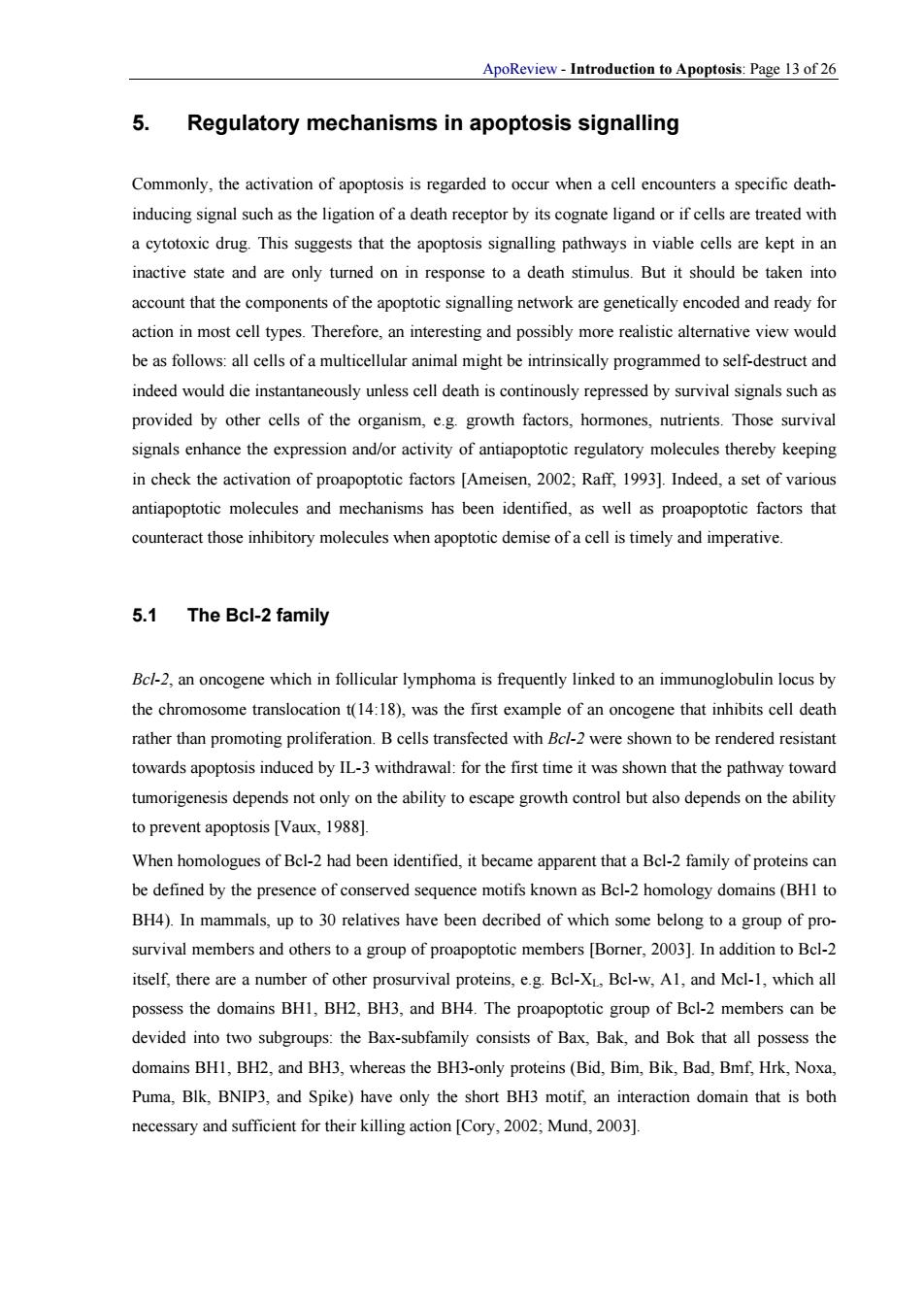正在加载图片...

ApoReview-Introduction to Apoptosis:Page 13 of 26 5. Regulatory mechanisms in apoptosis signalling Commonly,the activation of apoptosis is regarded to occur when a cell encounters a specific death- inducing signal such as the ligation ofa death receptor by its cognate ligand or ifcellsare treated with a cytotoxic drug.This suggests that the apoptosis signalling pathways in viable cells are kept in an inactive state and are only turned on in response to a death stimulus.But it should be taken into account that the components of the apoptotic signalling network are genetically encodd and ready for action in most cell types.Therefore,an interesting and possibly more realistic alternative view would be as follows:all cells of a multicellular animal might be intrinsically programmed to self-destruct and indeed would die instantaneously unless cell death is continously repressed by survival signals such as provided by other cells of the organism,e.g.growth factors,hormones,nutrients.Those survival signals enhance the expression and/or activity of antiapoptotic regulatory molecules thereby keeping in check the activation of proapoptotic factors [Ameisen,2002.Raff,1993].Indeed,a set of various antiapoptotic molecules and mechanisms has been identified,as well as proapoptotic factors that counteract those inhibitory molecules when apoptotic demise ofa cellis timely and imperative 5.1 The Bcl-2 family Bcl-2,an oncogene which in follicular lymphoma is frequently linked to an immunoglobulin locus by the chromosome translocation t(14:18),was the first example of an oncogene that inhibits cell death rather than promoting proliferation.Bcells transfected with Bl-were shown to be rendered resistant towards apoptosis induced by IL-3 withdrawal:for the first time it was shown that the pathway toward tumorigenesis depends not only on the ability to escape growth control but also depends on the ability to prevent apoptosis [Vaux,19] When homologues of Bel-2 had been identified,it became apparent that a Bel-2 family of proteins can be defined by the presence of conserved sequence motifs known as Bel-2 homology domains(BHI to BH4).In mammals,up to 30 relatives have been decribed of which some belong to a group of pro- survival members and others toa group of proapoptotic members [Borer,2003].In addition to Bcl-2 itself,there are a number of other prosurvival proteins,e.g.Bel-XBel-w,Al,and Mel-1,which all possess the domains BHI.BH2.BH3,and BH4.The proapoptotic group of Bcl-2 members can be devided into two subgroups:the Bax-subfamily consists of Bax Bak,and Bok that all possess the domains BH1,BH2,and BH3,whereas the BH3-only proteins(Bid,Bim,Bik,Bad,Bmf,Hrk,Noxa, Puma,Blk,BNIP3,and Spike)have only the short BH3 motif,an interaction domain that is both necessary and sufficient for their killing ction [Cory,:Mund,03]ApoReview - Introduction to Apoptosis: Page 13 of 26 5. Regulatory mechanisms in apoptosis signalling Commonly, the activation of apoptosis is regarded to occur when a cell encounters a specific deathinducing signal such as the ligation of a death receptor by its cognate ligand or if cells are treated with a cytotoxic drug. This suggests that the apoptosis signalling pathways in viable cells are kept in an inactive state and are only turned on in response to a death stimulus. But it should be taken into account that the components of the apoptotic signalling network are genetically encoded and ready for action in most cell types. Therefore, an interesting and possibly more realistic alternative view would be as follows: all cells of a multicellular animal might be intrinsically programmed to self-destruct and indeed would die instantaneously unless cell death is continously repressed by survival signals such as provided by other cells of the organism, e.g. growth factors, hormones, nutrients. Those survival signals enhance the expression and/or activity of antiapoptotic regulatory molecules thereby keeping in check the activation of proapoptotic factors [Ameisen, 2002; Raff, 1993]. Indeed, a set of various antiapoptotic molecules and mechanisms has been identified, as well as proapoptotic factors that counteract those inhibitory molecules when apoptotic demise of a cell is timely and imperative. 5.1 The Bcl-2 family Bcl-2, an oncogene which in follicular lymphoma is frequently linked to an immunoglobulin locus by the chromosome translocation t(14:18), was the first example of an oncogene that inhibits cell death rather than promoting proliferation. B cells transfected with Bcl-2 were shown to be rendered resistant towards apoptosis induced by IL-3 withdrawal: for the first time it was shown that the pathway toward tumorigenesis depends not only on the ability to escape growth control but also depends on the ability to prevent apoptosis [Vaux, 1988]. When homologues of Bcl-2 had been identified, it became apparent that a Bcl-2 family of proteins can be defined by the presence of conserved sequence motifs known as Bcl-2 homology domains (BH1 to BH4). In mammals, up to 30 relatives have been decribed of which some belong to a group of prosurvival members and others to a group of proapoptotic members [Borner, 2003]. In addition to Bcl-2 itself, there are a number of other prosurvival proteins, e.g. Bcl-XL, Bcl-w, A1, and Mcl-1, which all possess the domains BH1, BH2, BH3, and BH4. The proapoptotic group of Bcl-2 members can be devided into two subgroups: the Bax-subfamily consists of Bax, Bak, and Bok that all possess the domains BH1, BH2, and BH3, whereas the BH3-only proteins (Bid, Bim, Bik, Bad, Bmf, Hrk, Noxa, Puma, Blk, BNIP3, and Spike) have only the short BH3 motif, an interaction domain that is both necessary and sufficient for their killing action [Cory, 2002; Mund, 2003]